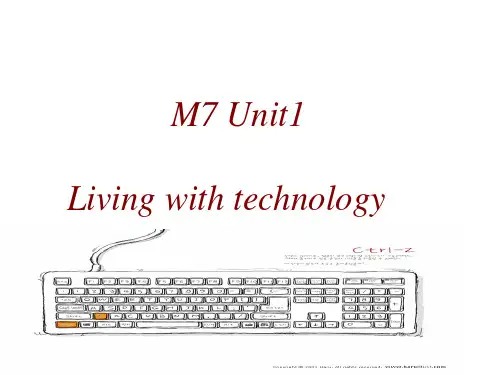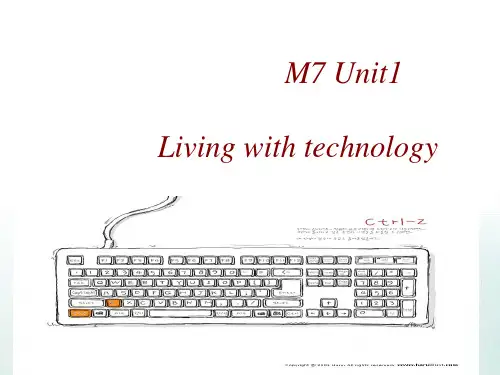牛津高中英语模块七unit1 Reading
- 格式:ppt
- 大小:1017.00 KB
- 文档页数:25


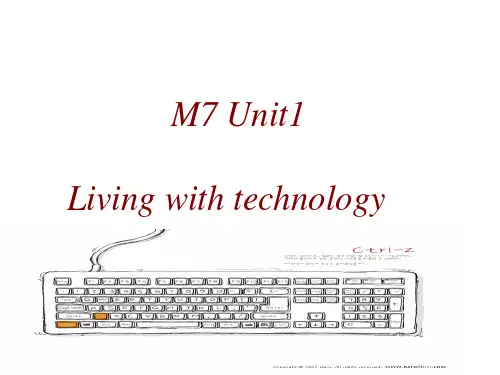
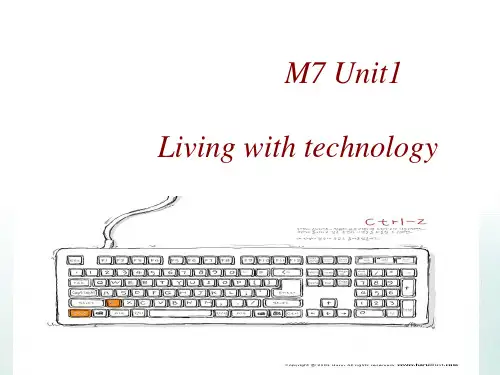

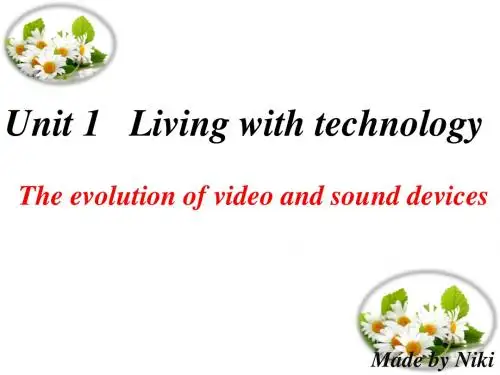
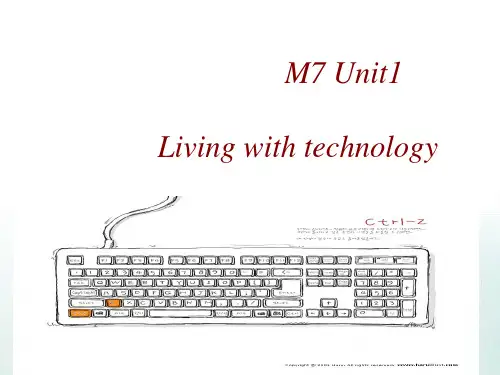
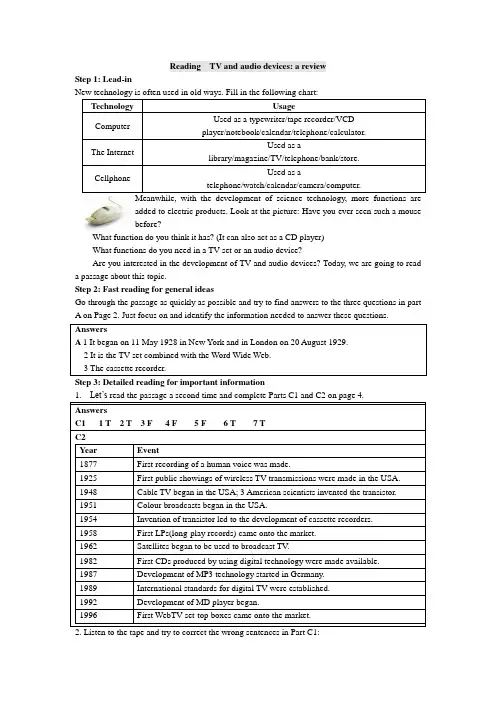
Reading TV and audio devices: a review Step 1: Lead-inTechnology UsageComputerUsed as a typewriter/tape recorder/VCD player/notebook/calendar/telephone/calculator.The InternetUsed as alibrary/magazine/TV/telephone/bank/store.CellphoneUsed as atelephone/watch/calendar/camera/computer.added to electric products. Look at the picture: Have you ever seen such a mouse before?What function do you think it has? (It can also act as a CD player)What functions do you need in a TV set or an audio device?Are you interested in the development of TV and audio devices? Today, we are going to read a passage about this topic.Step 2: Fast reading for general ideasGo through the passage as quickly as possible and try to find answers to the three questions in part A on Page 2. Just focus on and identify the information needed to answer these questions. AnswersA 1 It began on 11 May 1928 in New York and in London on 20 August 1929.2 It is the TV set combined with the Word Wide Web.3 The cassette recorder.Step 3: Detailed reading for important informationAnswersC1 1 T 2 T 3 F 4 F 5 F 6 T 7 TC2Year Event1877 First recording of a human voice was made.1925 First public showings of wireless TV transmissions were made in the USA. 1948 Cable TV began in the USA; 3 American scientists invented the transistor. 1951 Colour broadcasts began in the USA.1954 Invention of transistor led to the development of cassette recorders.1958 First LPs(long-play records) came onto the market.1962 Satellites began to be used to broadcast TV.1982 First CDs produced by using digital technology were made available.1987 Development of MP3 technology started in Germany.1989 International standards for digital TV were established.1992 Development of MD player began.1996 First WebTV set-top boxes came onto the market.2. Listen to the tape and try to correct the wrong sentences in Part C1:3. Read the text again and choose the best answers according to the text:1) When and where was the first long-distance TV broadcast made?A. In 1925 in the USA.B. In 1926 in the UK.C. In 1928 in the UK.D. In 1928 in both the USA and the UK.2) Who might be the inventor of the first TV?A. Vladimir Zworykin from Russia.B. Philo Farnsworth in the USA.C. John Logie Baird from Scotland.D. It remains uncertain.3) How many countries have put digital TV into operation according to the passage?A. Only one.B. Already two.C. At most three.D. At least four.4) Who might have attributed to the development of the Walkman?A. Two Japanese engineers.B. Three American scientists.C. Thomas Edison.D. Emile Berliner.5) What is the main factor that causes the spring up of music websites all over the Internet?A. The popularity of Walkman.B. The development of the MD player.C. The development of MP3 technology.D. The wide use of Discman.6) How is the passage organized ___________________.A. by paragraphsB. in chronological orderNow, read the Reading strategy on page 3. Attention: subtitles appear after titles and provide more information about the text and subtitle can show how a text is organized. Read the passage again and figure out how this text is organized.TVEarly history of TV(In order of time) The modern age: Cable TV , satellite TV, digital TV ,…Audio devices Early history of audio devices(By types of equipment) Tape recorders and playersSounds goes digitalWhich of the following best shows the structure of the passage?A. TB. TC. TD. TNow we can see that the reading passage is mainly organized in chronological order. A timeline or a time chart may help you understand the text better. Could you make a timeline by yourselves? Step 4: Practice:1. Besides the reading strategy, I ’d like to give you another tip on reading. Do not refer to the dictionary every time you come across a new word. Just guess the meaning from the context. It is①② ④ ⑤ ③ ① ② ③④ ⑤① ③ ② ③④ ⑤① ③ ② ③④ ⑤very important to read the sentences before and after the sentence which contains the unknown word. From the information before and after, you should be able to guess the meaning of the word. Now let’s complete Part D on page 4.AnswersD 1 e 2 d 3 h 4 c 5 g 6 f 7 a 8 b2. Wang Li attended a media technology exhibition and after that he gives a report to hisAnswersE (1) wireless (2) broadcasting (3) Britain (4) 65(5) 200 (6) households (7) recording (8) recorders(9) compact (10) GermanyStep 5: Post-reading activities1. Pair work:Choose one of the greatest inventions in human’s history that you are most familiar with. Try to tell your partner about its development. Remember that you should organize your reporter in orderFor referenceA Quick History of BicyclesThe Walking MachineIn 1817 Baron von Drais invented a walking machine thatwould help him get around the royal gardens faster: twosame-size in-line wheels, the front one steerable, mounted in a frame which you straddled. The device was propelled by pushing your feet against the ground, thus rolling yourself and the device forward in a sort of gliding walk. The machine became known asthe Draisienne or hobby horse. It was made entirely of wood. This enjoyed a short lived popularity as a fad, not being practical for transportation in any other place than a well maintained pathway such as in a park or garden.The Velocipede or BoneshakerThe next appearance of a two-wheeled riding machine was in 1865, when pedals were applied directly to the front wheel. This machine was known as the velocipede ("fast foot"), but was popularly known as the bone shaker, since it was also made entirely of wood, then later with metal tires, and the combination of these with the cobblestoneroads of the day made for an extremely uncomfortable ride. They also became a fad, andindoor riding academies, similar to roller rinks, could be found in large cities.The High Wheel BicycleIn 1870 the first all metal machine appeared. (Previous to this metallurgy was not advanced enough to provide metal which was strong enough to make small, light partsout of.) The pedals were still attached directly to the front wheel with no freewheeling mechanism. Solid rubber tires and the long spokes of the large front wheel provided amuch smoother ride than its predecessor. The front wheels became larger and larger as makers realized that the larger the wheel, the farther you could travel with one rotation ofthe pedals. You would purchase a wheel as large as your leg length would allow. This machine was the first one to be called a bicycle ("two wheel"). These bicycles enjoyed agreat popularity among young men of means (they cost an average worker six month'spay), with the hey-day being the decade of the 1880s.The High Wheel TricycleWhile the men were risking their necks on the high wheels,ladies, confined to their long skirts and corsets, could take aspin around the park on an adult tricycle. These machines alsoafforded more dignity to gentlemen such as doctors andclergymen. Many mechanical innovations now associated withthe automobile were originally invented for tricycles. Rack andpinion steering, the differential, and band brakes, to name afew!The High Wheel SafetyImprovements to the design began to be seen, many with the small wheel in the front to eliminate the tipping-forward problem. One model was promoted by its manufacturer bybeing ridden down the front steps of the capitol building in Washington, DC. These designs became known as high-wheel safety bicycles. Since theolder high-wheel designs had been known simply as bicycles,they were now referred to as "ordinary bicycles" in comparisonwith the new-fangled designs, and then simply as "ordinaries."The Hard-Tired SafetyThe further improvement of metallurgy sparked the next innovation, or rather return to previous design. With metal that was now strong enough to make a fine chain and sprocket small and light enough for a human being to power, the next design was a returnto the original configuration of two same-size wheels, only now,instead of just one wheel circumference for every pedal turn, youcould, through the gear ratios, have a speed the same as the hugehigh-wheel. The bicycles still had the hard rubber tires, and in theabsence of the long, shock-absorbing spokes, the ride theyprovided was much more uncomfortable than any of thehigh-wheel designs. Many of these bicycles of 100 years ago hadfront and/or rear suspensions. These designs competed with each other, your choice beingthe high-wheel's comfort or the safety's safety, but the next innovation tolled the death ofthe high-wheel design.The Pneumatic-Tired SafetyThe pneumatic tire was first applied to the bicycle by an Irish veterinarian who wastrying to give his young son a more comfortable ride on his tricycle. This inventiveyoung doctor's name was Dunlop. Sound familiar? Now that comfort and safety could behad in the same package, and that package was getting cheaper as manufacturing methods improved, everyone clamored to ride the bicycle. This 1898 Yale uses a shaftdrive to dispense with the dirty chain.2. Group work:Undoubtedly, in the future, both TV and audio devices will still play a very important role in human’s life. But they’ll certainly be advanced than those of today. Let’s work in pairs and design future TVs or audio devices.3. Let’s come to Part F. Work in pairs and share your opinions with each other.4. Discussion: What functions would you like your TVs or audio devices to have in the future?1.Read the text again and again. Try to memorize the language points.2.Parts A1 and A2 on pages106 & 107 in Workbook.。
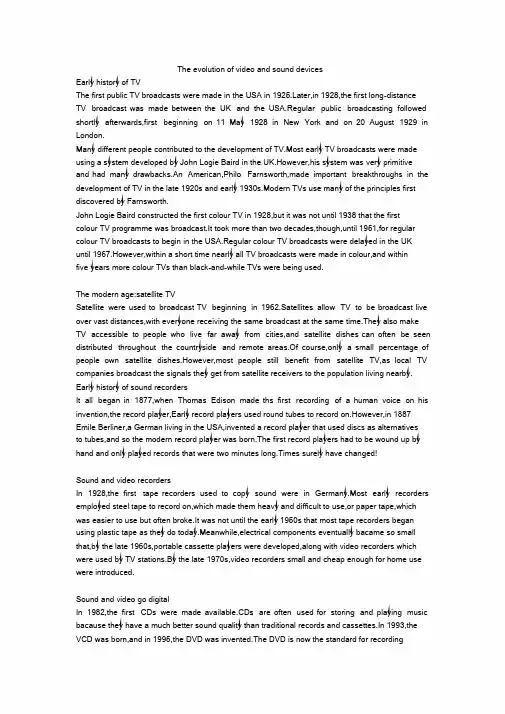
The evolution of video and sound devicesEarly history of TVThe first public TV broadcasts were made in the USA in ter,in 1928,the first long-distanceTV broadcast was made between the UK and the USA.Regular public broadcasting followed shortly afterwards,first beginning on 11 May 1928 in New York and on 20 August 1929 in London.Many different people contributed to the development of TV.Most early TV broadcasts were made using a system developed by John Logie Baird in the UK.However,his system was very primitiveand had many drawbacks.An American,Philo Farnsworth,made important breakthroughs in the development of TV in the late 1920s and early 1930s.Modern TVs use many of the principles first discovered by Farnsworth.John Logie Baird constructed the first colour TV in 1928,but it was not until 1938 that the firstcolour TV programme was broadcast.It took more than two decades,though,until 1951,for regular colour TV broadcasts to begin in the USA.Regular colour TV broadcasts were delayed in the UKuntil 1967.However,within a short time nearly all TV broadcasts were made in colour,and withinfive years more colour TVs than black-and-while TVs were being used.The modern age:satellite TVSatellite were used to broadcast TV beginning in 1962.Satellites allow TV to be broadcast live over vast distances,with everyone receiving the same broadcast at the same time.They also make TV accessible to people who live far away from cities,and satellite dishes can often be seen distributed throughout the countryside and remote areas.Of course,only a small percentage of people own satellite dishes.However,most people still benefit from satellite TV,as local TV companies broadcast the signals they get from satellite receivers to the population living nearby. Early history of sound recordersIt all began in 1877,when Thomas Edison made ths first recording of a human voice on his invention,the record player,Early record players used round tubes to record on.However,in 1887 Emile Berliner,a German living in the USA,invented a record player that used discs as alternativesto tubes,and so the modern record player was born.The first record players had to be wound up by hand and only played records that were two minutes long.Times surely have changed!Sound and video recordersIn 1928,the first tape recorders used to copy sound were in Germany.Most early recorders employed steel tape to record on,which made them heavy and difficult to use,or paper tape,which was easier to use but often broke.It was not until the early 1950s that most tape recorders began using plastic tape as they do today.Meanwhile,electrical components eventually bacame so small that,by the late 1960s,portable cassette players were developed,along with video recorders which were used by TV stations.By the late 1970s,video recorders small and cheap enough for home use were introduced.Sound and video go digitalIn 1982,the first CDs were made available.CDs are often used for storing and playing music bacause they have a much better sound quality than traditional records and cassettes.In 1993,the VCD was born,and in 1995,the DVD was invented.The DVD is now the standard for recordingand playing back video.The future With the development of digital technology,sound and video can now be stored on a PC,on the Internet,or using some form of portable storage.This will soon make records,cassette recorders,CDs,DVDs and even TVs things of the past.Technology is now changing faster than most people can keep pace with.Who can foresee what the future will bring?。
